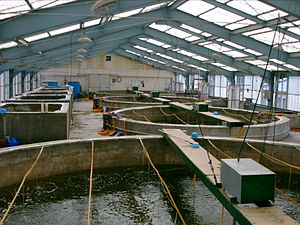May 30, 2017
By Anna Varriano
 [printfriendly]
[printfriendly]
Shrimp is the most popular seafood in North America, but I’d rather not eat it, and you might feel the same way after reading this blog. Here are the 5 main reasons why I typically avoid eating shrimp:
1 – Harmful food additives used to prevent discoloration
I have read a few articles that mention that a food additive is used to prevent discoloration in shrimp. Apparently, this additive has estrogen-like effects in the body that may reduce sperm count in men and increase breast cancer risk in women.
2 – Polluted shrimp farms
 I teach nutrition classes at the International Academy of Natural Health Sciences, where one of the foundational recommendations is to avoid eating shrimp as most contain toxins and harbour parasites that can harm our health. Why is this? It has to do with how most of the shrimp we eat are farmed. Shrimp farming crams tons of shrimp into small ‘ponds’ – just like the overcrowded conditions related to conventional beef/chicken/etc farming. Overcrowded conditions increase the risk of disease for most living things. Imagine all of these farmed shrimp crammed into a small man-made ‘pond’. The water gets polluted with their poop (and potentially other substances in and around the farming facility) and this polluted water is a breeding ground for bacteria and parasites (check out the picture below of a typical parasite … kinda looks like a shrimp, don’t you think?). Can you guess what the solution to this pollution problem is? Read #3 to find out!
I teach nutrition classes at the International Academy of Natural Health Sciences, where one of the foundational recommendations is to avoid eating shrimp as most contain toxins and harbour parasites that can harm our health. Why is this? It has to do with how most of the shrimp we eat are farmed. Shrimp farming crams tons of shrimp into small ‘ponds’ – just like the overcrowded conditions related to conventional beef/chicken/etc farming. Overcrowded conditions increase the risk of disease for most living things. Imagine all of these farmed shrimp crammed into a small man-made ‘pond’. The water gets polluted with their poop (and potentially other substances in and around the farming facility) and this polluted water is a breeding ground for bacteria and parasites (check out the picture below of a typical parasite … kinda looks like a shrimp, don’t you think?). Can you guess what the solution to this pollution problem is? Read #3 to find out!

3 – Antibiotics and disinfectants
If you said dumping tons of antibiotics and/or disinfectants and other chemicals into the water, you got it! While many of these substances are banned in North America, most shrimp are farmed elsewehere – and when we eat those shrimp, we also ingest the antibiotics and disinfectants they were exposed to. Some of these chemicals/pesticides are neurotoxins (neuro = nervous system; toxins = poisons); that is, they can harm delicate nervous system tissue, including the brain. Think ADHD, Parkinson’s and memory loss as examples of health issues that can be caused or exasperated by neurotoxins.
elsewehere – and when we eat those shrimp, we also ingest the antibiotics and disinfectants they were exposed to. Some of these chemicals/pesticides are neurotoxins (neuro = nervous system; toxins = poisons); that is, they can harm delicate nervous system tissue, including the brain. Think ADHD, Parkinson’s and memory loss as examples of health issues that can be caused or exasperated by neurotoxins.
4 – Mystery origins
You might be thinking that the solution would be to buy wild shrimp (aka Gulf shrimp), and that may be a good idea, if it weren’t for the fact that some testing found that 25% of shrimp samples labeled as wild were actually farm-raised. Additionally, much of the shrimp eaten by North Americans is imported without being labelled as such, so we have no way of knowing if what we’re eating is wild and clean, or farmed and toxic.
5 – Sketchy inspections
90% of the shrimp we eat in North America is imported – and many sources state that less than 2% of imported shrimp gets inspected by government regulatory agencies.
If you still want to eat shrimp, here’s some advice.
I do my best to avoid shrimp when eating out or when invited to dinner parties by letting the servers/hosts know that I’m allergic to shellfish. It’s taken seriously as shellfish allergies can cause very severe symptoms.
While I’ve never had any food allergy testing, thankfully, I typically feel a bit ‘off’ when I eat shellfish. Why do I say ‘thankfully’? Because I see this as my body doing me a favour and telling me, through unpleasant symptoms, to stay away from it.
If you still want to eat shrimp after reading this article, here’s a resource from Seafood Watch that will help you make the best choices when buying shrimp, as well as other shellfish and fish. They even have a great app you can download for convenient use while you’re shopping.

Take control of what you can!
References
Shrimp Nutrition: Is Shrimp Healthy or Harmful to Your Health?
6 Disgusting Facts About Farmed Shrimp
[printfriendly]
Join my email list and start living healthier!
- Tips & advice on healthier living
- Special promotions & offers
- Sent a few times a month to your inbox

Subscribe today and you'll receive a free e-guide that outlines the four key supplements you need for lifelong health!